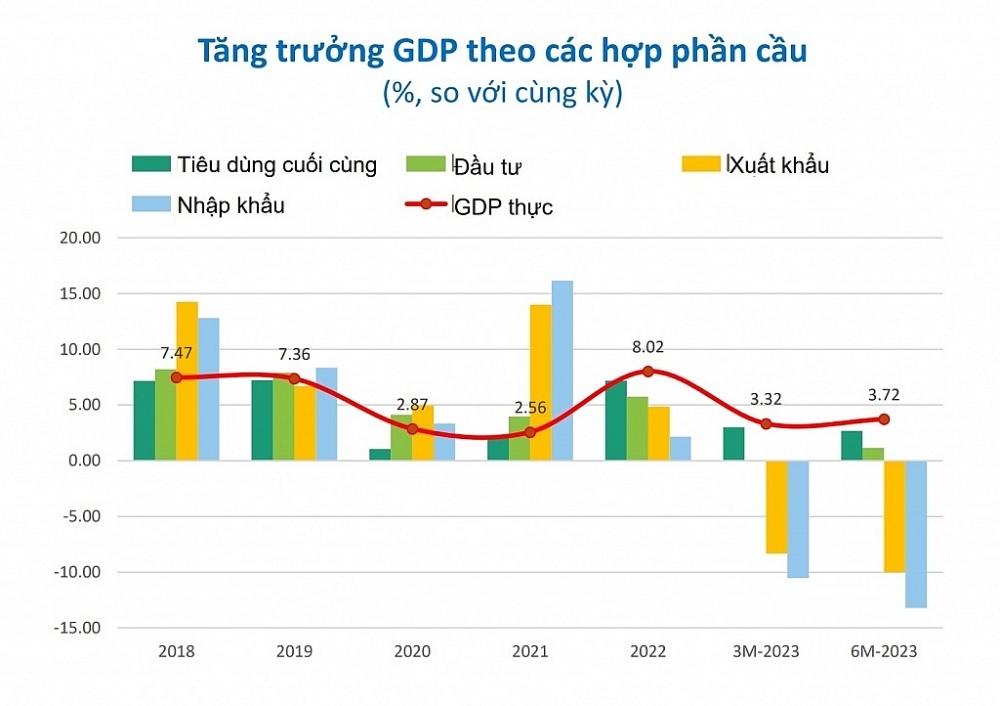Policy breakthrough to revive aggregate demand and promote growth
 |
| Source: General Statistics Office, WB |
Indicators of declining aggregate demand
Aggregate demand is used to measure the overall economic activity of a country. In theory, the aggregate demand of an economy is the total value of all goods and services produced in a certain period. It is typically calculated from personal consumption, investment, government spending, and exports. Analyzing the results that our economy has achieved in the past six months, the weakness of aggregate demand is evident.
Specifically, issues related to production and exports have experienced "low notes." According to the General Department of Customs, despite maintaining a high trade surplus of US$12.84 billion, the export turnover has decreased significantly by 12% compared to the same period last year due to low demand from major markets. Exports to the US market recorded the sharpest decline at 22.6%, the EU decreased by 10.1%, and South Korea decreased by 10.2%.
In the report on the Purchasing Managers' Index (PMI) of June 2023 by S&P Global, Vietnam's manufacturing PMI reached 46.2 points, an increase from the May figure of 45.3 points. However, this index still remained below the threshold of 50 points for the fourth consecutive month. This reflected the continued decline in the "health" of Vietnam's manufacturing sector due to a decrease in the number of new orders.
According to the results of the business trend survey of processing and manufacturing enterprises in the second quarter of 2023 by the General Statistics Office, as many as 36.2% of businesses reported a decrease in orders during the second quarter of 2023. In the third quarter of 2023, 26.3% of enterprises expect a decrease in orders. Regarding export orders, these figures are 38.3% and 27.1%, respectively. According to experts, economic growth is still hindered, and many developed countries continue to stick to tight monetary policies amid high inflation, which may delay the improvement of external demand for export goods.
Along with the indicators from business production situations, the reduction in aggregate demand is also evident in weak credit demand. Credit to the economy in the past six months increased by 4.73%, compared to 8.51% in the same period last year. The low credit growth indicated the economy's limited ability to absorb capital, despite a decreasing trend in interest rates compared to 2022. The State Bank of Vietnam (SBV) explained that the banking sector still maintained good liquidity to provide credit, but one of the reasons for low credit demand was the low investment and consumption demand, which prevented credit demand from increasing significantly.
Supporting market outlets for businesses
The unpredictable challenges in the global economy, combined with a decline in aggregate demand, have made Vietnam's target of 6.5% growth in 2023 very difficult to achieve. Vietnam's economy has a high degree of openness, and the rate of export growth is always higher than domestic consumption, making the economy increasingly dependent on the global market, leaving businesses more vulnerable. For many businesses today, the need for orders and market outlets for products is more critical than ever.
Therefore, identifying the real situation to support businesses is a crucial issue that needs to be addressed. In a recent seminar on recovering aggregate demand and promoting growth organized by the National Economics University, Assoc. Prof. Dr. Tran Dinh Thien, former Director of the Vietnam Institute of Economics, emphasized that we have only loosened policies, but without breakthrough policies, it would be difficult to address the difficulties. "In challenging times like this, we need unconventional solutions," he stressed.
Referring to the 2% interest rate support package, this expert believed that although the package was substantial, its disbursement was still limited, so we could not just talk about solutions but must find growth incentives for businesses.
Regarding this issue, many opinions suggested that strengthening the investment capital disbursement would indirectly create jobs and market outlets for businesses. However, according to Prof. Nguyen Dinh Cung, former Director of the Central Institute for Economic Management (CIEM), in fact, the slow disbursement of investment has lasted for many years. Although there has been improvement in the disbursement rate of public investment, it has not met expectations. The government has implemented many solutions, but according to Prof. Cung, the first thing to do is to resolve the "fear of making mistakes and reluctance to act" mentality. Additionally, it is necessary to review some provisions in the Public Investment Law and other related laws to identify obstacles.
Also related to stimulus measures and support for businesses, Johnathan Picus, the Chief Economist of the United Nations Development Programme (UNDP) in Vietnam, believed that Vietnam was relying too much on monetary policies to stimulate demand. The loosening of lending standards and lowering of interest rates has led to a decline in asset quality, creating "asset bubbles." Therefore, Vietnam needs more fiscal policy tools, specifically focusing on concentrated public investment linked with industrial and trade policies. The social welfare and subsidy system needs to be expanded and modernized.
Many economic experts also agreed that monetary policies were not a long-term effective solution. Economist Le Duy Binh, Director of Economica Vietnam, observed that continuing to use monetary policy tools, such as lowering interest rates for the economy, was indeed necessary but needed to be executed with caution, considering other macroeconomic indicators such as inflation, exchange rates, and budget deficits. Simultaneously, it is essential to recognize the fact that reducing interest rates is just one key to unlocking the flow of money; the other key lies in the ability to absorb and efficiently use capital by businesses and individuals.
Accompanying changes in policies are the solutions to enhance administrative procedure reforms, improve the business investment environment, remove barriers, establish frameworks for developing new economic models, and maintain investors' confidence, which has been a long-standing desire of the business community. Finding ways to create market outlets for businesses through trade promotion, exploiting domestic markets, and seeking export opportunities is crucial. Clearly, allowing businesses to develop on a solid foundation will reduce their vulnerability to external market fluctuations.
Related News

Complying with regulations of each market for smooth fruit and vegetable exports
13:06 | 09/01/2025 Import-Export

Coconut export enter acceleration cycle
11:02 | 30/12/2024 Import-Export

Increasing consumption demand, steel enterprises have many opportunities
07:43 | 31/12/2024 Import-Export
Latest News

Việt Nam tightens fruit inspections after warning from China
08:01 | 15/01/2025 Import-Export

Brand building key to elevate Vietnamese fruit and vegetable sector: experts
08:00 | 15/01/2025 Import-Export

Freight transport via China-Việt Nam cross-border trains posts rapid growth
08:01 | 13/01/2025 Import-Export

Vietnamese retail industry expects bright future ahead
06:22 | 11/01/2025 Import-Export
More News

Fruit and vegetable industry aims for $10 billion in exports by 2030
15:12 | 07/01/2025 Import-Export

GDP grows by over 7 per cent, exceeds target for 2024
15:11 | 07/01/2025 Import-Export

Vietnamese pepper: decline in volume, surge in value
15:10 | 07/01/2025 Import-Export

Việt Nam maintains position as RoK’s third largest trading partner
15:09 | 07/01/2025 Import-Export

Greater efforts to be made for stronger cooperation with European-American market
15:08 | 06/01/2025 Import-Export

Leather, footwear industry aims to gain export growth of 10% in 2025
15:06 | 06/01/2025 Import-Export

Grasping the green transformation trend - A survival opportunity for Vietnamese Enterprises
14:53 | 06/01/2025 Import-Export

Việt Nam to complete database of five domestic manufacturing industries in 2026
20:57 | 05/01/2025 Import-Export

Logistics firms optimistic about growth prospects in 2025: Survey
20:54 | 05/01/2025 Import-Export
Your care

Việt Nam tightens fruit inspections after warning from China
08:01 | 15/01/2025 Import-Export

Brand building key to elevate Vietnamese fruit and vegetable sector: experts
08:00 | 15/01/2025 Import-Export

Freight transport via China-Việt Nam cross-border trains posts rapid growth
08:01 | 13/01/2025 Import-Export

Vietnamese retail industry expects bright future ahead
06:22 | 11/01/2025 Import-Export

Complying with regulations of each market for smooth fruit and vegetable exports
13:06 | 09/01/2025 Import-Export
